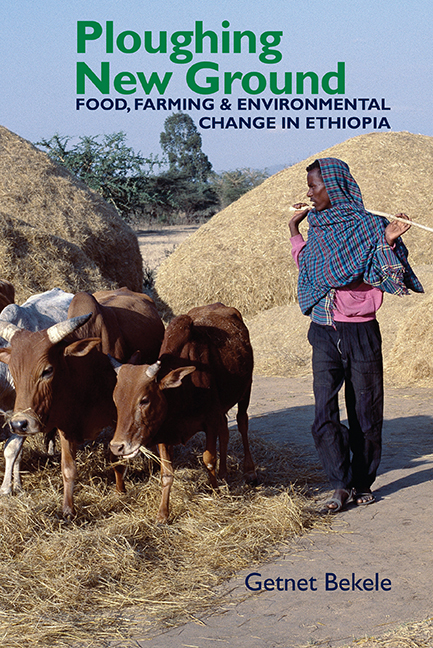Book contents
- Frontmatter
- Dedication
- Contents
- List of Maps and Tables
- Acknowledgements
- Note on Orthography
- Acronyms & Abbreviations
- Glossary
- Map
- Introduction
- 1 Landscape Pastoral: The making and remaking of a grassland environment, 1886–1916
- 2 Negotiating a Landscape: Continuity and change in a grassland environment, 1917–1941
- 3 Blurring the Boundaries: The ascendancy of crop production in a flexible environment, 1942–1955
- 4 Fresh Encounters and Morphing Strategies: The changing organization of production in an era of agricultural intervention, 1956–1965
- 5 Inputs, Outputs and the Farm: Transformations in the science, politics and praxis of agricultural development, 1966–1974
- 6 Competition and Co–existence: Creating space for small- to large-scale farming, 1966-1974
- 7 Of Production and Production Relations: Farming in an era of revolutionary change and socialist development, 1975–1991
- 8 Vicious Circle: Agricultural development at the time of ‘revolutionary democracy’, 1991–2016
- Conclusion
- Bibliography
- Index
- Eastern African Studies
1 - Landscape Pastoral: The making and remaking of a grassland environment, 1886–1916
Published online by Cambridge University Press: 31 August 2018
- Frontmatter
- Dedication
- Contents
- List of Maps and Tables
- Acknowledgements
- Note on Orthography
- Acronyms & Abbreviations
- Glossary
- Map
- Introduction
- 1 Landscape Pastoral: The making and remaking of a grassland environment, 1886–1916
- 2 Negotiating a Landscape: Continuity and change in a grassland environment, 1917–1941
- 3 Blurring the Boundaries: The ascendancy of crop production in a flexible environment, 1942–1955
- 4 Fresh Encounters and Morphing Strategies: The changing organization of production in an era of agricultural intervention, 1956–1965
- 5 Inputs, Outputs and the Farm: Transformations in the science, politics and praxis of agricultural development, 1966–1974
- 6 Competition and Co–existence: Creating space for small- to large-scale farming, 1966-1974
- 7 Of Production and Production Relations: Farming in an era of revolutionary change and socialist development, 1975–1991
- 8 Vicious Circle: Agricultural development at the time of ‘revolutionary democracy’, 1991–2016
- Conclusion
- Bibliography
- Index
- Eastern African Studies
Summary
The patchwork quilt of intensively cultivated fields, an impressive array of cultivars, chemically fertilized soils and marketed food and flower production that characterized Ethiopia's lake region's agro-environment at the dawn of the third millennia contrasted sharply with the situation that had prevailed on the ground nearly a century ago. At the close of the nineteenth century, this region was in fact a predominantly pastoral landscape. In addition, it was a fiercely contested territory. Its major protagonists included an increasingly diverse group of populations – both pastoralists and cultivators – residing in the lake region and its coterminous highlands and lowlands on a permanent or seasonal basis. Also active in that race for territory and resources was the Ethiopian state, whose advent after 1889 marked an important turning point in that region's history. This was mainly because of the state's voracious appetite for land and for food, which it wanted to enclose and to exact by one means or another. Despite its efforts, the Ethiopian state nonetheless had difficulty accomplishing its goals in that region in with any speed. Conversely, subject populations were in a position to quickly develop the mechanisms that helped them to co-opt, subvert and appropriate to their advantage some of the rules and practices that the state was trying to promote in the lake region after that year. This is an important point because, as this chapter seeks to demonstrate, their success, rather than the sheer power of the micro-environment, was what contributed to the retrenchment and propagation of a pastoral landscape in the lake region in the contemporary period.
POPULATIONS, PLACES AND INSTITUTIONS OF SOCIAL CONTROL
A person travelling in the lake region sometime in the mid- to latenineteenth century would have encountered a predominantly grassland environment that was home to diverse groups of populations that spoke different languages and different dialects of the same language. Two or more dialects of the Oromo language were what the populations residing north of the Modjo River, portions of the Maqi River Valley, and in the triangular area that stretched from Mito (a village south of present-day Zway town) to Arsi Nagelle and Aje spoke in that period. Likewise, the Sidama language was likely the most dominant in the highlands that straddled Lake Awasa and Daddaba, the river that marks the southern limits of present-day Arsi Nagelle town.
- Type
- Chapter
- Information
- Ploughing New GroundFood, Farming & Environmental Change in Ethiopia, pp. 22 - 40Publisher: Boydell & BrewerPrint publication year: 2017

